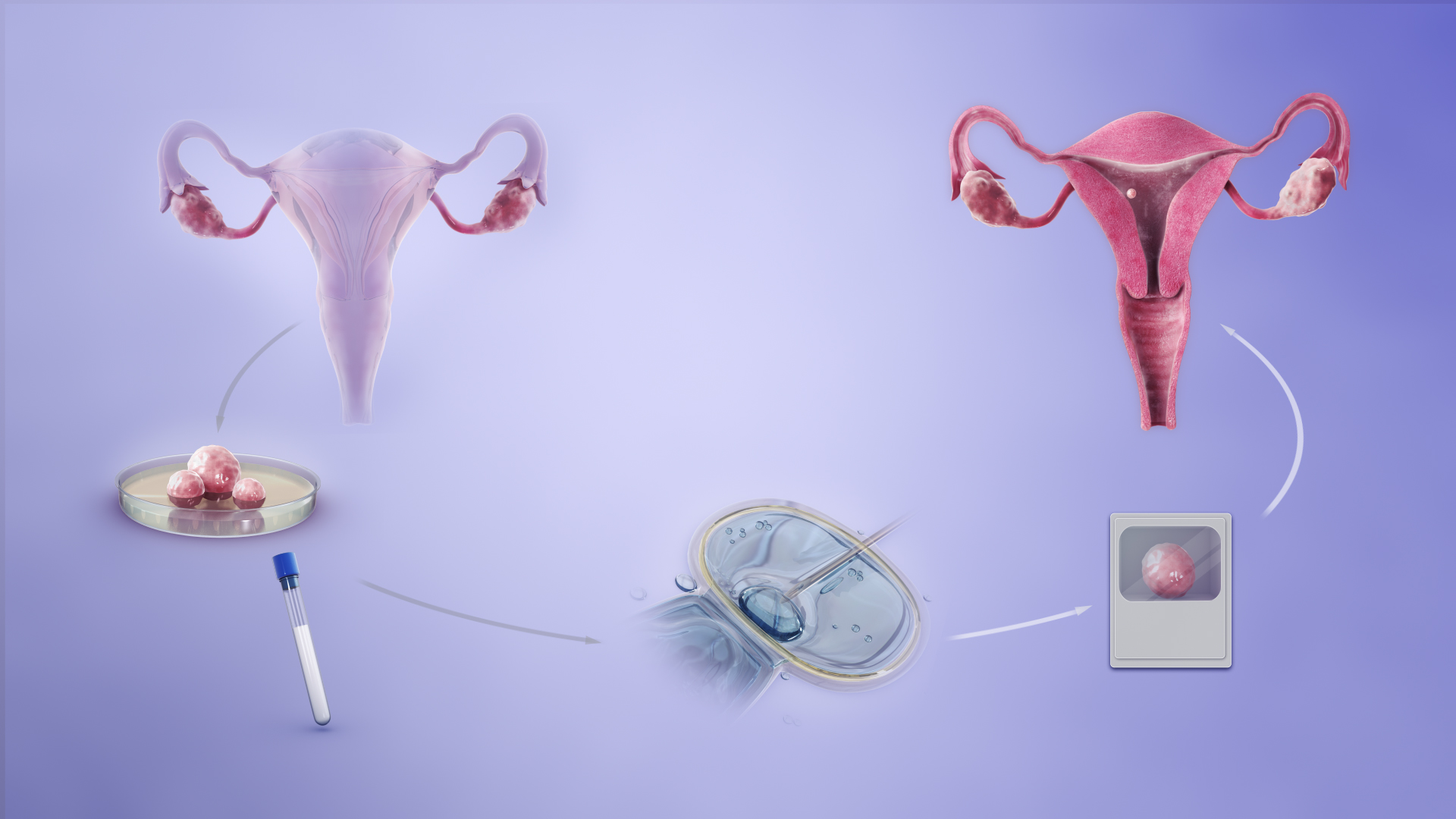|
Birmingham Women's Fertility Centre
The Birmingham Women's Fertility Centre at Birmingham Women’s Hospital, Birmingham, England, formerly named the "Assisted Conception Unit", is one of the UK's leading medical centres for infertility treatment and care. It is the longest established fertility clinic in the Midlands, marking thirty years operations in the year 2010. The clinic is based in an NHS hospital and provides integrated care to both NHS and private patients; the staff is internationally recognised for their work in treating with infertility. The clinic runs active programmes of egg-sharing, sperm donation and egg-donation. Care advances The Fertility Centre was one of five clinics selected around the UK to receive Medical Research Council funding to elevate the IVF laboratories to ‘cleanroom’ levels. This is fundamental for producing human embryonic stem cells Embryonic stem cells (ESCs) are pluripotent stem cells derived from the inner cell mass of a blastocyst, an early-stage pre- implantation e ... [...More Info...] [...Related Items...] OR: [Wikipedia] [Google] [Baidu] |
Birmingham Women’s Hospital
Birmingham Women's and Children's NHS Foundation Trust ran Birmingham Women's Hospital in the Edgbaston area of Birmingham, situated very close to the University of Birmingham. On 1 February 2008, it was granted NHS Foundation Trust Status. It merged into Birmingham Women's and Children's NHS Foundation Trust in 2017 Services The first Birmingham maternity hospital was established in 1842 to reduce the number of women and children dying needlessly from puerperal fever and childbirth related infections. This hospital has been at its present site since 1994, and is one of only two trusts in the UK specialising in women's health care. They provide a focused range of health care services, primarily, though not exclusively, to women and their families. These are: *Maternity and foetal medicine services *Neonatal care and newborn transport service *Milk bank—the only one in the West Midlands. It provides donor breast milk for its own neonatal babies and also distributes donor br ... [...More Info...] [...Related Items...] OR: [Wikipedia] [Google] [Baidu] |
Birmingham
Birmingham ( ) is a City status in the United Kingdom, city and metropolitan borough in the metropolitan county of West Midlands (county), West Midlands, within the wider West Midlands (region), West Midlands region, in England. It is the List of English districts by population, largest local authority district in England by population and the second-largest city in Britain – commonly referred to as the second city of the United Kingdom – with a population of million people in the city proper in . Birmingham borders the Black Country to its west and, together with the city of Wolverhampton and towns including Dudley and Solihull, forms the West Midlands conurbation. The royal town of Sutton Coldfield is incorporated within the city limits to the northeast. The urban area has a population of 2.65million. Located in the West Midlands (region), West Midlands region of England, Birmingham is considered to be the social, cultural, financial and commercial centre of the Midland ... [...More Info...] [...Related Items...] OR: [Wikipedia] [Google] [Baidu] |
Infertility
In biology, infertility is the inability of a male and female organism to Sexual reproduction, reproduce. It is usually not the natural state of a healthy organism that has reached sexual maturity, so children who have not undergone puberty, which is the body's start of fertility, reproductive capacity, are excluded. It is also a normal state in women after menopause. In humans, ''infertility'' is defined as the inability to become pregnant after at least one year of unprotected and regular sexual intercourse involving a male and female partner. There are many causes of infertility, including some that Assisted reproductive technology, medical intervention can treat. Estimates from 1997 suggest that worldwide about five percent of all heterosexual couples have an unresolved problem with infertility. Many more couples, however, experience involuntary childlessness for at least one year, with estimates ranging from 12% to 28%. Male infertility is responsible for 20–30% of infert ... [...More Info...] [...Related Items...] OR: [Wikipedia] [Google] [Baidu] |
Medical Research Council (UK)
The Medical Research Council (MRC) is responsible for co-coordinating and funding medical research in the United Kingdom. It is part of United Kingdom Research and Innovation (UKRI), which came into operation 1 April 2018, and brings together the UK's seven research councils, Innovate UK and Research England. UK Research and Innovation is answerable to, although politically independent from, the Department for Business, Energy and Industrial Strategy. The MRC focuses on high-impact research and has provided the financial support and scientific expertise behind a number of medical breakthroughs, including the development of penicillin and the discovery of the structure of DNA. Research funded by the MRC has produced 32 Nobel Prize winners to date. History The MRC was founded as the Medical Research Committee and Advisory Council in 1913, with its prime role being the distribution of medical research funds under the terms of the National Insurance Act 1911. This was a conseq ... [...More Info...] [...Related Items...] OR: [Wikipedia] [Google] [Baidu] |
Cleanroom
A cleanroom or clean room is an engineered space that maintains a very low concentration of airborne particulates. It is well-isolated, well-controlled from contamination, and actively cleansed. Such rooms are commonly needed for scientific research and in industrial production for all nanoscale processes, such as semiconductor device manufacturing. A cleanroom is designed to keep everything from dust to airborne organisms or vaporised particles away from it, and so from whatever material is being handled inside it. A cleanroom can also prevent the escape of materials. This is often the primary aim in hazardous biology, nuclear work, pharmaceutics, and virology. Cleanrooms typically come with a cleanliness level quantified by the number of particles per cubic meter at a predetermined molecule measure. The ambient outdoor air in a typical urban area contains 35,000,000 particles for each cubic meter in the size range 0.5 μm and bigger, equivalent to an ISO 9 certified c ... [...More Info...] [...Related Items...] OR: [Wikipedia] [Google] [Baidu] |
Human Embryonic Stem Cells
Embryonic stem cells (ESCs) are pluripotent stem cells derived from the inner cell mass of a blastocyst, an early-stage pre- implantation embryo. Human embryos reach the blastocyst stage 4–5 days post fertilization, at which time they consist of 50–150 cells. Isolating the inner cell mass (embryoblast) using immunosurgery results in destruction of the blastocyst, a process which raises ethical issues, including whether or not embryos at the pre-implantation stage have the same moral considerations as embryos in the post-implantation stage of development. Researchers are currently focusing heavily on the therapeutic potential of embryonic stem cells, with clinical use being the goal for many laboratories. Potential uses include the treatment of diabetes and heart disease. The cells are being studied to be used as clinical therapies, models of genetic disorders, and cellular/DNA repair. However, adverse effects in the research and clinical processes such as tumors and unwante ... [...More Info...] [...Related Items...] OR: [Wikipedia] [Google] [Baidu] |
HFEA
The Human Fertilisation and Embryology Authority (HFEA) is an executive non-departmental public body of the Department of Health and Social Care in the United Kingdom. It is a statutory body that regulates and inspects all clinics in the United Kingdom providing ''in vitro'' fertilisation (IVF), artificial insemination and the storage of human eggs, sperm or embryos. It also regulates human embryo research. Background to the establishment of the HFEA After the birth of Louise Brown, the world's first IVF baby, in 1978, there was concern about the implications of this new technology. In 1982, the UK government formed a committee chaired by philosopher Mary Warnock to look into the issues and see what action needed to be taken. Hundreds of interested individuals including doctors, scientists and organisations such as health, patient and parent organisations as well as religious groups gave evidence to the committee. In the years following the Warnock report, proposals were br ... [...More Info...] [...Related Items...] OR: [Wikipedia] [Google] [Baidu] |
Centre For Human Reproductive Science (ChRS)
The Centre for Human Reproductive Science was established in December 2006 to further develop research and innovation in fertility diagnosis and treatment, working in partnership as the academic and research wing of the Birmingham Women's Fertility Centre at Birmingham Women's Hospital and the University of Birmingham Medical School. A particular emphasis in the biomedical research strategy is placing research and discovery in the true physiological context. Research and funding The current focus and funding of the Centre includes: * Evaluation of the clinical and cost-effectiveness of three cycles of IUI versus one of IVF. The UNiTY trial funded by the National Institute for Health and Care Research (NIHR). * Research into advanced computer-assisted diagnosis of male fertility issues - initially funded by the EPSRC - culminating in the development of the FAST (Flagellar Analysis and Sperm Tracking) software. * Translational medicine research funded by the National Institute for ... [...More Info...] [...Related Items...] OR: [Wikipedia] [Google] [Baidu] |
Medical Research Institutes In The United Kingdom
Medicine is the science and practice of caring for patients, managing the diagnosis, prognosis, prevention, treatment, palliation of their injury or disease, and promoting their health. Medicine encompasses a variety of health care practices evolved to maintain and restore health by the prevention and treatment of illness. Contemporary medicine applies biomedical sciences, biomedical research, genetics, and medical technology to diagnose, treat, and prevent injury and disease, typically through pharmaceuticals or surgery, but also through therapies as diverse as psychotherapy, external splints and traction, medical devices, biologics, and ionizing radiation, amongst others. Medicine has been practiced since prehistoric times, and for most of this time it was an art (an area of creativity and skill), frequently having connections to the religious and philosophical beliefs of local culture. For example, a medicine man would apply herbs and say prayers for heali ... [...More Info...] [...Related Items...] OR: [Wikipedia] [Google] [Baidu] |
Fertility Medicine
Reproductive endocrinology and infertility (REI) is a surgical subspecialty of obstetrics and gynecology that trains physicians in reproductive medicine addressing hormonal functioning as it pertains to reproduction as well as the issue of infertility. While most REI specialists primarily focus on the treatment of infertility, reproductive endocrinologists are trained to also test and treat hormonal dysfunctions in females and males outside infertility. Reproductive endocrinologists have specialty training (residency) in obstetrics and gynecology (ob-gyn) before they undergo sub-specialty training (fellowship) in REI. Reproductive surgery is a related specialty, where a physician in ob-gyn or urology further specializes to operate on anatomical disorders that affect fertility. Certification In a number of countries, the pathway to become a subspecialist in REI is regulated. Thus, in the United States, for instance, the American Board of Obstetrics and Gynecology (ABOG) and Amer ... [...More Info...] [...Related Items...] OR: [Wikipedia] [Google] [Baidu] |
In Vitro Fertilisation
In vitro fertilisation (IVF) is a process of fertilisation in which an ovum, egg is combined with spermatozoon, sperm in vitro ("in glass"). The process involves monitoring and stimulating the Ovulation cycle, ovulatory process, then removing an ovum or ova (egg or eggs) from the ovary, ovaries and enabling sperm to fertilise them in a culture medium in a laboratory. After a fertilised egg (zygote) undergoes embryo culture for 2–6 days, it is Embryo transfer, transferred by catheter into the uterus, with the intention of establishing a successful pregnancy. IVF is a type of assisted reproductive technology used to treat infertility, enable gestational surrogacy, and, in combination with pre-implantation genetic testing, avoid the transmission of abnormal genetic conditions. When a fertilised egg from egg and sperm donors Implantation (embryology), implants in the uterus of a genetically unrelated surrogate, the resulting child is also genetically unrelated to the surrogate. ... [...More Info...] [...Related Items...] OR: [Wikipedia] [Google] [Baidu] |



